Java基础—IO小结(一)概述与节点流
一、File类的使用
由于file类是一个基础类,所以我们从file类开始了解。(SE有完善的中文文档,建议阅读)
构造器:

常用方法:——完整方法请参见API API API!!!
File做的是面上的事——文件的新建、删除、重命名等。有关文件内容的操作,需要流来进行,所以,它经常作为形参。
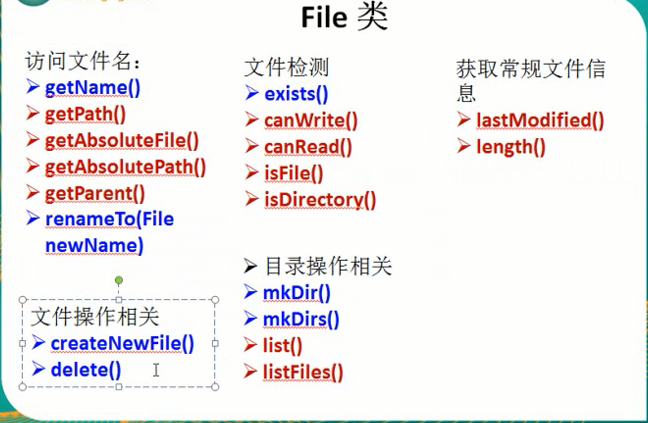
文件名:
测试文件:

测试代码:

@Test public void test1() { // 通过绝对路径创建File对象——对应一个文件或者文件夹 File file = new File("D:\\test\\hello.txt"); // getName()——文件或目录名 System.out.println("#getName:"+file.getName()); // getPath()——路径字符串,若是相对路径,返回相对路径字符串 System.out.println("#getPath:"+file.getPath()); // getAbsoluteFile()——绝对路径形式,返回File System.out.println("#getAbsoluteFile() "+file.getAbsoluteFile()); // getAbsolutePath()——绝对路径字符串 System.out.println("#getAbsolutePath() "+file.getAbsolutePath()); // getParent() ——返回父目录 System.out.println("#getParent() "+file.getParent()); }
测试结果:
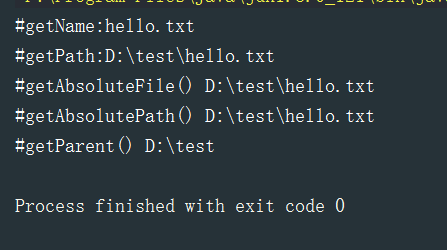
文件检测:
测试文件:

测试代码:

@Test public void test2() { File file1 = new File("D:\\test\\hello.txt"); // 文件 File file2 = new File("D:\\test\\childDir"); // 文件夹 // exists()——文件或目录是否存在 System.out.println("#exists()"+file1.exists()); // canRead() canWrite() ——是否可读可写 System.out.println("#canRead()"+file1.canRead()); System.out.println("#canWrite()"+file1.canWrite()); // isFile() isDirectory() ——是否是文件/目录 System.out.println("#isFile()"+file1.isFile()); System.out.println("#isFile()"+file2.isFile()); System.out.println("#isDirectory()"+file1.isDirectory()); System.out.println("#isDirectory()"+file2.isDirectory()); }
测试结果:
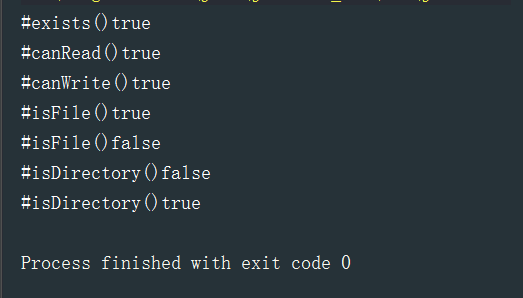
获取常规文件信息:
测试文件:上文hello.txt
测试代码:

@Test public void test3() { File file = new File("D:\\test\\hello.txt"); // lastModified() ——文件最后修改时间 System.out.println("lastModified() :"+ new Date(file.lastModified())); // length()——文件长度(字节) System.out.println("length:"+file.length()); }
测试结果:

文件操作相关:
测试代码:

@Test public void test4() throws IOException { File file = new File("D:\\test\\hello1.txt"); //文件不存在 // createNewFile() ——不存在时创建新文件 if (!file.exists()) { boolean b = file.createNewFile(); System.out.println("创建空文件结果:"+ b); } // delete() ——文件长度(字节) System.out.println("delete() :" + file.delete()); }
测试结果:

目录操作相关:
测试文件:
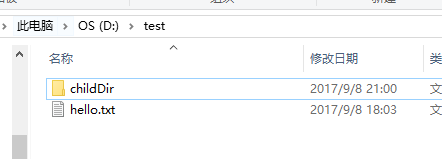
测试代码:

@Test public void test5() throws IOException { File file1 = new File("D:\\test\\childDir"); // 文件夹 if (!file1.exists()) { // mkdir()——创建一个文件目录 mkdirs()——递归创建 boolean b = file1.mkdir(); System.out.println("新建文件夹结果:"+ b); } File file = new File("D:\\test"); // 与Linux命令的ls类似,list返回字符串,listFiles返回文件 String[] files = file.list(); for (String s : files) { System.out.println(s); } }
测试结果:
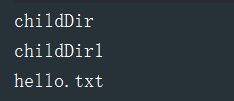
二、IO流的分类
读取外部设备中到程序中,称之为 input,输入;从程序向外输出到外部,称之为 ouput,输出;
也就是,站在程序的角度来理解输入输出!
A.根据处理数据类型的不同分为:字符流和字节流
B.根据数据流向不同分为:输入流和输出流
C.按功能分:节点流(一线的,离源最近的)和处理流

都是由四个最基本的 抽象类派生而成

三、节点流的使用

请注意:由于流不是JVM的资源,不会被回收,所以:必须手动显式关闭!
1.fis与fos
FileInputStream
构造器:

方法摘要:输入流对应读的方法

read()方法:

@Test public void testFis1() throws Exception{ // 从硬盘读取一个文件(File类与文件建立联系),将其文件内容读取到程序中 File file = new File("D:\\test\\hello.txt"); // 通过file构建一个输入流 FileInputStream fis = new FileInputStream(file); // 调用fis的方法进行文件的操作 /* * read():读取文件的一个字节(java中int为4字节),到结尾时返回-1 * */ // int b = fis.read(); // while (b != -1) { // System.out.print((char)b); // b = fis.read(); // } int b; while ((b = fis.read()) != -1) { System.out.print((char)b); } // 必须手动关闭流! fis.close(); }
结果:

//实际上,txt中文件为Hello World,仔细看 72便是H的ASCII值(char型转为Int型了)
若要显示英文字符,可以进行强转:
System.out.print((char)b);
当然,这里直接thorws的做法是及其不靠谱的,至少,当前面出现异常时,后续的代码(如colse())不会继续执行,也就是说,资源无法关闭!
我们稍加改进:—— IO的操作请注意写法!

@Test public void testFis2(){ FileInputStream fis = null; try { // 从硬盘读取一个文件(File类与文件建立联系),将其文件内容读取到程序中 File file = new File("D:\\test\\hello.txt"); // 通过file构建一个输入流 fis = new FileInputStream(file); // 调用fis的方法进行文件的操作 int b; while ((b = fis.read()) != -1) { System.out.print((char)b); } } catch (IOException e) { e.printStackTrace(); } finally { // 必须手动关闭流! try { fis.close(); } catch (IOException e) { e.printStackTrace(); } } }
当然,一个一个字节读,在实际中是不可能的,我们可以使用它的重载方法:
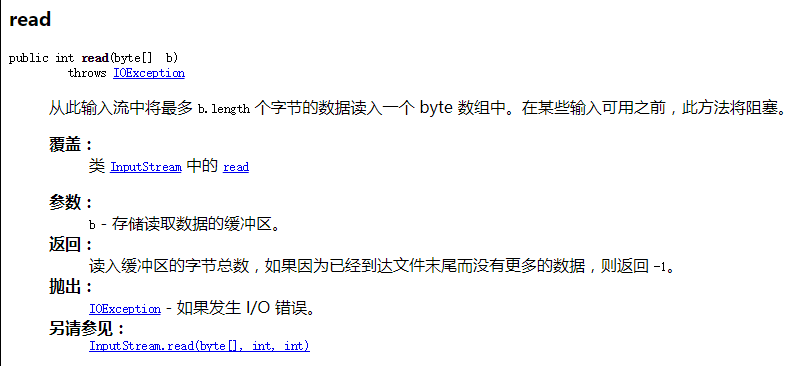

@Test public void testFis3() { FileInputStream fis = null; try { File file = new File("D:\\test\\hello.txt"); fis = new FileInputStream(file); // 定义每次读取的字节数组,这里定义长度为5 byte[] bytes = new byte[5]; int len; // 每次读取的字节长度 while ((len = fis.read(bytes)) != -1) { /* 这里必须注意bytes.length与len的区别,len是实际读到的长度, bytes.length是数组长度,可能会有之前读到的老的字符,读到的字节是依次放入bytes中, 将原先数组的进行替换,若未替换完,则保留了老的字节,不能遍历! */ for (int i = 0; i < len; i++) { System.out.print((char)bytes[i]); } } } catch (IOException e) { e.printStackTrace(); } finally { try { // 手动关闭流 fis.close(); } catch (IOException e) { e.printStackTrace(); } } }
//相关注意的问题请看注释!
FileOutputStream
构造器:

方法摘要:对应写的方法

测试代码:

@Test public void testFos1() { // 文件可以不存在,将会自动创建 File file = new File("D:\\test\\hello1.txt"); FileOutputStream fos = null; try { // 同样,使用文件作为构造器,关联上一个文件 fos = new FileOutputStream(file); // 使用字节数组写入数据到文件 fos.write(new String("I love China").getBytes()); System.out.println("fos done!"); } catch (IOException e) { e.printStackTrace(); } finally { if (fos != null) { //增加空判断,防止空指针异常 try { fos.close(); } catch (IOException e) { e.printStackTrace(); } } } }
//稍微改进异常处理时流的关闭引发的NPE
结果:若文件存在不是追加,而是直接覆盖文件

fos与fis实现文件的复制:
测试代码:

@Test public void testFisAndFos1() { // 已经存在,用于输入流读取 File file1 = new File("D:\\test\\0.jpg"); // 不存在,用于输入流写出 File file2 = new File("D:\\test\\1.jpg"); FileInputStream fis = null; FileOutputStream fos = null; try { fis = new FileInputStream(file1); fos = new FileOutputStream(file2); int len; byte[] bytes = new byte[5]; while ((len = fis.read(bytes)) != -1) { // 将取到的字节写入新的文件,注意读的长度 // 考虑 fos.write(bytes);的写法的错误之处 fos.write(bytes, 0, len); } } catch (IOException e) { e.printStackTrace(); } finally { if (fis != null) { try { fis.close(); } catch (IOException e) { e.printStackTrace(); } } if (fos != null) { try { fos.close(); } catch (IOException e) { e.printStackTrace(); } } } }
// 后续将会升级为缓冲流
测试结果:

// 无论字节或者字符,都可以使用字节流进行处理
2.fr与fw
FileReader与FileWriter处理的步骤与上述是基本一样的,不同的是字符流处理的单位稍有差异
构造器:


FileReader
测试代码:

@Test public void testFr1() { File file = new File("D:\\test\\hello.txt"); FileReader fr = null; try { // 同样的,根据文件构建一个输入流 fr = new FileReader(file); int len; // 实际操作请根据文件大小修改字符数组大小 char[] cbuf = new char[5]; while ((len = fr.read(cbuf)) != -1) { String s = new String(cbuf, 0, len); System.out.print(s); } } catch (IOException e) { e.printStackTrace(); } finally { if (fr != null) { try { fr.close(); } catch (IOException e) { e.printStackTrace(); } } } }
测试结果即为输出文本文件到控制台
FileReader与FileWriter进行文本文件复制与之前类似,只是数组类型不同:

@Test public void testFrAndFw1() { // 需要关联的文件 File file1 = new File("D:\\test\\hello.txt"); File file2 = new File("D:\\test\\hello3.txt"); FileReader fr = null; FileWriter fw = null; try { // 通过文件创建流 fr = new FileReader(file1); fw = new FileWriter(file2); int len; char[] cbuf = new char[5]; while ((len = fr.read(cbuf)) != -1) { fw.write(cbuf, 0, len); } } catch (IOException e) { e.printStackTrace(); } finally { if (fr != null) { try { fr.close(); } catch (IOException e) { e.printStackTrace(); } } if (fw != null) { try { fw.close(); } catch (IOException e) { e.printStackTrace(); } } } }
相关文章
- Java开发高质量代码建议1:三元操作符的类型务必一致
- java基础—网络编程——TCP客户端与服务端交互
- 阿里P8熬了一个月肝出这份32W字Java面试手册,在Github标星31K+
- 记录年前Java岗整个历程(附字节,阿里,百度,网易,美团等面经)
- java中如何将string转化成long
- 解决Maven无法下载fastdfs-client-java依赖,Dependency 'org.csource:fastdfs-client-java:1.27-SNAPSHOT' not found.
- 分布式技术EJB3_分库架构 - 【动力节点官网】北京Java …
- java调用phantomjs采集ajax加载生成的网页
- java中CompletionService的使用
- java.util.concurrent简介
- japonensisjava乱码_Java乱码问题原因及解决方案
- java中XML操作:xml与string互转、读取XML文档节点及对XML节点增删改查
- Java基础-封装基础知识和拓展
- Java 23种设计模式详尽分析与实例解析之二--结构型模式
- Java中删除数组中重复元素
- 【JAVA】2.输入一个复杂链表(每个节点中有节点值, 以及两个指针,一个指向下一个节点, 另一个特殊指针指向任意一个节点), 返回结果为复制后复杂链表的head。 (注意,输出结果中请不要返回参数中
- 【JAVA】输入一个链表,输出该链表中倒数第k个结点。


